35 years of Te Hunga Rōia Māori
WINTER 2023
This design represents the 35 years of Te Hunga Rōia Māori o Aotearoa and its legacy, and honours those who have passed on as well. The design reflects the successes, rangatira o te ture and the generations of Māori lawyers to come.
Design by Nikki Kennedy of Taputapu Toi
ABOUT LAWTALK
LawTalk is published quarterly by the New Zealand Law society | Te Kāhui Ture o Aotearoa for the legal profession. It has been published since 1974 and is available to every New Zealand-based lawyer who holds a current practising certificate.
DISCLAIMER
unless it is clearly indicated, the views expressed in LawTalk are not to be taken as those of, or endorsed by the New Zealand Law society | Te Kāhui Ture o Aotearoa. No responsibility whatsoever is accepted by the Law society for any opinion, information, or advertisement contained in LawTalk
CONTACT DETAILS
publications@lawsociety.org.nz
PO Box 5041, Wellington 6140, New Zealand DX sP 20202
ADVERTISING
For advertising placement:
advertising@lawsociety.org.nz
PRINTING AND DISTRIBUTION
Blue star, Petone, Wellington IssN 0114-989X (Print) · IssN 2382-0330 (Digital)
PEOPLE Frazer Barton, President
David Campbell, Vice President Auckland
Caroline Silk, Vice President Central North Island
Ataga’i Esera, Vice President Wellington
Taryn Gudmanz, Vice President south Island
Katie Rusbatch, Chief executive Officer
STORY SUGGESTIONS
Do you have a suggestion for a story idea you think would be interesting for an upcoming issue of LawTalk? email: publications@lawsociety.org.nz
Issue 954 ∙ W INT e R 2023
***** FPO ***** Placeholder for FSC Certificate ***** FPO ***** Mā te Ture, Mō te Iwi By the Law, For the People nā Renika Siciliano and Baden Vertongen .... 04 A proud 35 year history of Te Hunga Rōia Māori nā Frazer Barton 06 Moana Jackson - His legacy nā Baden Vertongen 10 The aftermath of Cyclone Gabrielle 18 Waitangi Tribunal, Treaty settlements and beyond nā Tara Hauraki .......................... 22 Te Reo Māori and Tikanga in our Courts nā Rebekah Bright 26 Kia Hohou te Rongo nā Wi Pere Mita ............. 28 Protecting and enhancing tikanga for future generations ...................................... 30 Bringing Te Hunga Rōia Māori together nā Renika Siciliano 33 The Independent Review review nā Baden Vertongen ........................................ 36 He Kai Kei Āku Ringa - Financing Māori freehold land nā Kylee Katipo 38 Practising certificate fee to rise by $140 in 2023-2024 ....................................... 41
3
Contents
Mā te Ture, Mō te Iwi By the Law, For the People
NĀ RENIKA SICILIANO AND BADEN VERTONGEN
EMoana, nāu i takahi i te ara, nāu i whakatūria i te pae hei whāinga mā mātou, moe okioki rā e te Rangatira.
E ngā rau awa o ngā waka o te motu, e ngā maunga whakahī o neherā, nei rā ngā mihi i runga anō i ngā āhuatanga o te wā, tae atu ki ō tātou tini aituā. Kua tangihia o tātou tini mate huri noa i te motu. Nā reira, tēnā koutou katoa
Mā te Ture, Mō te Iwi – By the Law, For the People. This is the kaupapa/ vision of Te Hunga Rōia Māori o Aotearoa. This kaupapa has been fundamental throughout the 35-year history of Te Hunga Rōia Māori, from humble beginnings in 1988 to today where we are able to celebrate the successes of members in all parts of the profession and all parts of Aotearoa.
As we celebrate 35 years, the story of Te Hunga Rōia Māori has been one of bravery, resilience, challenge, change, excellence, and above all, rangatiratanga.
Already in 2023, we have seen these
qualities come to the fore amongst both our legal community but also the wider community and iwi we serve. We have not yet hit winter but have seen Huripare Kāpiriere (Cyclone Gabrielle) and other extreme weather events devastate many of our communities, while in the midst a year of political challenge and uncertainty.
We have seen the end of an era with the retirement of Judge Wilson Isaacs from the roles of Chief Judge of the Māori Land Court and Chair of the Waitangi Tribunal after almost 14 years. On behalf of Te Hunga Rōia Māori and no doubt all those appearing in those forums, we thank Chief Judge Isaacs for his humility, his leadership, and his humour.
We celebrate that for the first time ever, the Māori Land Court has an even split of male and female judges on the bench, with Acting Chief Judge Caren Fox at the helm. The Māori Land Court is now the only court in the country to have a balanced representation. We also celebrate the appointment of Judge
Sheena Tepania as the first Māori Environment Court Judge, and the judicial appointments of Judge Alana Thomas (Māori Land Court), Judge Tania Williams (Family Court) and Judge Ngaroma Tahana (District Court).
Though the year has already brought challenges for many, there has certainly been moments to treasure. As a country, we have witnessed the unity and manaakitanga of iwi through natural disasters and revelled in the magnificent contributions of Te Hunga Rōia Māori members at Te Matatini (on stage and off).
Our resilience has meant that for every down, there is an up. And still, as lawyers, we continue – mā te ture, mō te iwi.
In doing so, we acknowledge Matua Moana Jackson and his immeasurable contribution to the law and to Te Hunga Rōia Māori. Words cannot do justice to this. Not only did Matua Moana contribute so much personally, the ripples of his
LAWTALK ∙ KŌR e RO MŌ T e T u R e
4
influence and support for others in the law are endless.
This edition seeks to honour his legacy as we reflect on important mahi across all areas of the law –from commercial law to whenua Māori, and to family and criminal spaces in the regions. In this edition, we also reflect on our journey in respect of Te Tiriti o Waitangi and look to the place of alternative dispute resolution in our future. This is but a small part of what ngā rōia Māori are doing everyday to help the Māori communities they are part of. We look forward to further celebrating our members and their efforts at our Hui-ā-Tau/Annual Conference, to be held in Kirikiriroa, Hamilton in August 2023.


FAR LeFT: Renika siciliano, Tumuaki Wahine, Te Hunga Rōia Māori
LeFT: Baden Vertongen, Tumuaki Tane, Te Hunga Rōia Māori
We dedicate this edition to Matua Moana and all those who have paved the way for us today, enabling us to be ourselves within the profession and who have inspired – and often challenged - us to continue their legacies.
Te tōrino haere whakamua, whakamuri. ▪
Ngā manaakitanga
Renika Siciliano and Baden Vertongen
Issue 954 ∙ W INT e R 2023
“We dedicate this edition to Matua Moana and all those who have paved the way for us today, enabling us to be ourselves within the profession and who have inspired – and often challenged –us to continue their legacies”
5
A proud 35 year history of Te Hunga Rōia Māori
NĀ FRAZER BARTON
In many ways, working for the betterment of people is what we all aspire to do as lawyers. But special recognition should be given to the kaupapa that Te Hunga Rōia Māori o Aotearoa / New Zealand Māori Law Society (Te Hunga Rōia Māori) has led over the last 35 years. Since 1988, Te Hunga Rōia Māori has made an incredible contribution to the profession, to the public and to the practice of law in Aotearoa New Zealand. Not only the members of Te Hunga Rōia Māori who have gone on to achieve many ‘firsts’ but also the many hundreds – if not thousands –of members who have in their own way made the establishment do things differently.
The relationship between the Law Society and Te Hunga Rōia Māori is a special one and it is a relationship I value a great deal. The many aspects of the work we do together – whether recently through the Independent Review, or on other special projects to attract more Māori into the

profession and strive towards better diversity across all levels and areas of the law – are crucial to a more modern, inclusive, diverse and representative legal profession here in Aotearoa New Zealand.
The contribution Māori have made more generally is also something we should celebrate more publicly.
Right from when Sir Apirana Turupa Ngata was admitted as the first Māori barrister and solicitor in 1897, through to Dame Georgina te Heuheu being admitted as the first wahine Māori barrister and solicitor in 1972 and Justice Sir Joe Williams being elevated to the Supreme Court in 2019, many of these milestones are thoroughly worth celebrating. You will see a very important mihi to Moana Jackson – noted in ‘How it all began’ as Te Hunga Rōia Māori’s “champion of Māori jurisprudence and legal tikanga” – perhaps one of the most important Māori legal academics and champions of tikanga Aotearoa has ever had.
LAWTALK ∙ KŌR e RO MŌ T e T u R e
“The relationship between the Law Society and Te Hunga Rōia Māori is a special one... The many aspects of the work we do together... are crucial to a more modern, inclusive, diverse and representative legal profession here in Aotearoa New Zealand”
“Mahia te mahi, hei painga mō te iwi –work for the betterment of the people”
6
— Princess Te Puea Hērangi
I recently had the privilege of listening to some of our foremost experts on tikanga and the law, as I attended a fabulous wananga organised by Mai Chen and New Zealand Asian Lawyers – and I congratulate them on pulling together such a great event. The speakers included Justice Williams of the Supreme Court of New Zealand, Justice Whata of the High Court of New Zealand, Justice Powell of the High Court of New Zealand, Judge Taumaunu, Chief Judge of the District Court of New Zealand, Judge Fox Deputy Chief Judge of the Māori Land Court of New Zealand, and Judge Doogan of the Māori Land Court of New Zealand and alternate Judge of the Environment Court of New Zealand. Tikanga and the law is a fascinating, dynamic and critically important
area. It’s a positive development which makes us unique on the world stage. This is going to be a huge learning exercise for many of us as lawyers and I encourage you to embrace the opportunity.
By the time LawTalk reaches you, consultation on the recommendations from the Independent Review will have concluded and the Law Society will be shaping its response for consideration by the Minister of Justice. The Panel’s recommendation that a new statute for the regulation of lawyers should include a standalone, overarching Te Tiriti clause has received a lot of attention. There has been some commentary suggesting that the obligations would apply to individual practitioners. It is important to note, however, that this recommendation applies to a new
regulator, and not to lawyers or the duties they have. More information is available on the Law Society website.
I want to thank you for taking the time to feed back on these important recommendations that will hopefully change the profession for the better. The independent review is an important step forward to outlining the potential changes that are needed for the legal profession in the future, but it is going to take all of us working together to achieve the differences that are needed.
Finally, as I reflect on this edition of LawTalk, I want to thank Te Hunga Rōia Māori for their extensive contribution to the legal profession, doing the work to ensure Aotearoa New Zealand is a place that is better for all people. ▪

Issue 954 ∙ W INT e R 2023
7
Edward Durie (later sir edward Taihakurei Durie) is the first Māori to be appointed Chief Judge of the Māori Land Court

On 26 March, Apirana Turupa Ngata (later sir Apirana) is the first Māori to be admitted as a barrister and solicitor
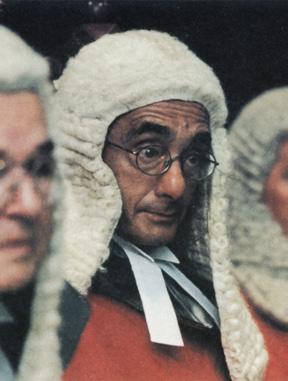
In June, Ken Mason is sworn in, becoming the first Māori to be appointed a stipendiary Magistrate (and later District Court Judge until his retirement in 1988)
Te reo Māori becomes an official language of New Zealand
Caren Wickliffe (later Acting Chief Judge Fox) is the first Māori woman appointed a Judge of the Māori Land Court
Edward Durie is sworn in as a High Court Judge in October, becoming the first Māori man appointed to the High Court bench
In July, Harold Herbert Carr is appointed to the bench of the Native (later Māori) Land Court, the first Māori to be appointed a judicial officer
The Waitangi Tribunal is established to hear and make recommendations on claims brought by Māori in respect of Crown breaches of Te Tiriti o Waitangi
Lowell Goddard (later Dame Lowell) is sworn in as a High Court Judge in December, becoming the first Māori woman appointed to the High Court bench

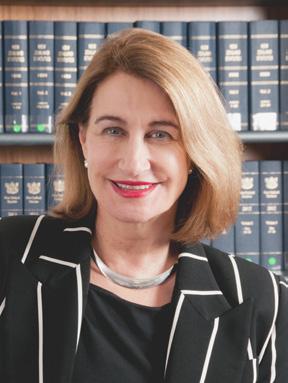
Georgina te Heuheu (later Dame Georgina) is the first Māori woman to be admitted as a barrister and solicitor
Te Hunga Rōia Māori o Aotearoa formally established, with just a handful of members
LAWTALK ∙ KŌR e RO MŌ T e T u R e 2000 1998 1995 1988 1987 1897 1923 1970 1972 1975 1980
Sir Apirana Turupa Ngata
Sir Edward Taihakurei Durie
Dame Lowell Goddard
8
Dame Georgina te Heuheu
Denise Clark is sworn in as a District Court Judge on Tematekapua Marae in Rotorua on 2 October. she is the first Māori woman appointed as a District Court Judge and it is also the first time a judge has been admitted to the bench in a ceremony held on a marae

Admission to the bar is held entirely in te reo Māori for the first time Te Ture mō Te Reo Māori/Māori Language Act gives people the right to speak te reo Māori in Court regardless of whether they can speak any other language
Te Hunga Rōia Māori hosts the inaugural kura reo for the legal sector at Hoani Waititi Marae in Auckland
February: Te Hunga Rōia Māori and NZLS sign Memorandum of understanding to strengthen the relationship
October: Te Hunga Rōia Māori becomes a permanent member of the New Zealand Law society Council
June: First swearing in of a High Court Judge on a marae is held at Te Waiiti Marae in Rotorua with the swearing in of Justice Kiri Tahana
December: First bilingual judgment is issued by the Māori Land Court from Judge Aidan Warren and Dr Ruakere Hond (appointed as pūkenga)
Justice Joe Williams is elevated to the supreme Court, as its first Māori appointed to the supreme Court bench
Khylee Quince is appointed Dean of Law at AuT, the first Māori Dean of Law at an Aotearoa university
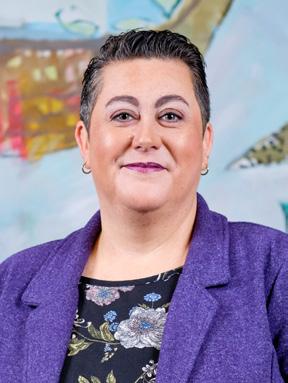
Justice Joe Williams is elevated to the Court of Appeal, as its first Te Reo speaking judicial officer and likely first Māori appointed to the Court of Appeal bench
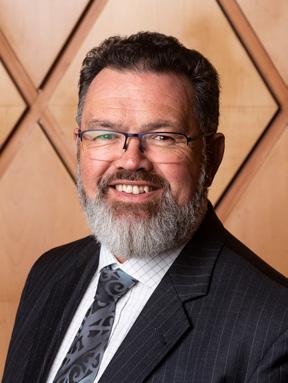
January: Te Hunga Rōia Māori launches regular webinar series
April: Sheena Tepania is the first wāhine Māori environment Court Judge, sworn in at Waihapa Marae in Kaeo
Issue 954 ∙ W INT e R 2023 2019 2018 2022 2021 2020 2023 2017 2012 2015 2016 2001
Te Hunga Rōia Māori hosts the inaugural World Indigenous Lawyers’ Conference in Hamilton
Acting Chief Judge Caren Fox
Khylee Quince
9
Justice Joe Williams
Moana Jackson –His legacy
NĀ BADEN VERTONGEN (NGĀTI RAUKAWA)
“Kaore tātou e noho tahi ai i roto i ō tātou whawhai, kei te tū tātou i te ao tūroa i te māramatanga o ō tātou tipuna”.
Ka puta te waihanga o te ture i Aotearoa i runga i te kaha o Moana Jackson.
He kaiwhakarauora i ngā tikanga tuku iho, he pou tangata i tō tātou reo Māori, ā, nānā i whakapau kaha i ngā whakaaro whai waahi ki roto i te Ao ture me te whakakotahi i ngā tāngata katoa huri noa i te ao.
Nānā i whawhai, i whakapau kaha anō hoki ki te tautoko i te mana me te rangatiratanga o te iwi Māori, kia whakarite i a rātou ake ture e hangai ana ki a rātou whakapapa, ā, kei te ora tonu ngā ture Māori, i roto i te mātauranga Māori.
Ka whawhai tonu mātou mō ake tonu atu.
Koia tētahi o ngā rangatira ka tū hei māngai, hei waha mā tātou te iwi Māori. Koia hoki tētahi i whakarauora ai, i whakahoki ai tō tātou nei tikanga Māori ki roto o Aotearoa, ki roto hoki i te Ao Ture.

It is impossible for Te Hunga Rōia Māori o Aotearoa to prepare an edition of LawTalk without an acknowledgement of Moana Jackson and his passing a little over a year ago.
Moana was an important figure for so many – for his whānau; for his iwi of Ngāti Kahungunu, Ngāti Porou, and Rongomaiwahine; for Māori working in a range of fields; and for indigenous peoples throughout the world through his work on the drafting of the United Nation’s Declaration on the Rights of Indigenous Peoples.
Included below are comments from some who knew him particularly well, and who carry on his work today. It is impossible to include thoughts from all those that he was special to, but the thoughts that are provided will echo those of many others.
This is because, for Māori lawyers in particular, Matua Moana was one of the pou, or pillars, for us as individuals and as part of Te Hunga Rōia Māori.
For so many of us we first came across Moana as part of our studies. At a time when we might often
LAWTALK ∙ KŌR e RO MŌ T e T u R e
10
be struggling in our courses and thinking law may not be for us, we would come across Moana Jackson and his thinking. This might have been a report or article by Moana that had snuck its way into our course material, or it might have been seeing Moana talking in person at any one of the law schools that he would go out of his way to give time to support. That would often be one of the first times we would really see ourselves, our experiences, our values, being expressed in the context of the legal courses that we were studying. His thinking would be a guiding star that helped us navigate through, and avoid being swamped in, a sea of dreary decisions written by English Law Lords.
As many others have said before, a ‘Moana Jackson moment’ was often what contributed to convincing them to stick with studying law. The growing number of Māori in the legal profession has its roots in seeds planted by Moana.
He also continued to nurture those seeds. At a recent reunion for Te Roopu Whai Pūtake (the Otago University Māori Law Students Association) Kristen Maynard, one of TRWP’s founders, shared her memories of Moana and his support for TRWP. She also talked of the experience of transitioning from being a student to having to start a professional career, and bumping into Moana at that time. When that happened Moana remembered her, knew her name, took the time to talk with her about how she was and what she was going to be doing

Issue 954 ∙ W INT e R 2023
11
LeFT: Moana Jackson
next. And when he discovered that Kristen was about to start a new job but didn’t have a pōwhiri arranged, made sure he was available the next day to step into the that role and support her in the next stage of her journey.
That is not an unusual story – many of the tributes and acknowledgements that were made at the time of Moana’s passing tell a similar tale. Of Moana taking the time to connect with everyone he met, of nurturing those connections, and going out of his way to support and mentor others (and sometimes give a gentle push when required).

Those seeds that were planted in the profession have grown and spread because of the care and love that Moana gave in nurturing them. Today many of those people are our senior members of Te Hunga Rōia Māori, of the profession, of academia, and are Government ministers or senior officials.
The direction of the growth of Māori in the legal profession, and the
growth of Te Hunga Rōia Māori, has also been guided, in no small part, by the thinking, values, and vision of Moana.
Within Te Hunga Rōia Māori, he often posed the question of whether there was a difference in seeing ourselves as lawyers who happen to be Māori, or as Māori who happen to be lawyers. And if there was a difference, then which are we as members of Te Hunga Rōia Māori?
That question remains a touchstone for us. It has given us the confidence to participate in the legal profession in a way that doesn’t mean we have to compromise our culture and values, in a way where we express our reo me ōna tikanga, and in a way where we support each other.
The work that we each do as lawyers also remains strongly influenced by Moana. His ground-breaking work such as He Whaipaanga Hou: Māori in the Criminal Justice System, and Matike Mai, as well as his involvement in milestones such as the UN Declaration on the Rights
of Indigenous Peoples, are the foundations we work from today. It is not hard to draw a direct line from Moana’s thinking and work through to the developments we see today – from the upcoming inclusion of the teaching of tikanga as part of a law degree, to some of the thinking behind the Te Ao Marama approach in the District Courts, through to the recognition of tikanga Māori as a third source of law in Aotearoa by the Supreme Court.
The whakataukī – kua hinga te tōtara i te wao nui a Tāne – was one that was often heard following Moana’s passing. It is an appropriate one. We have lost a great tōtara from our forest. But, like the tōtara, Moana sowed the seeds for the next generation, nurtured us to grow, and has shown us the direction to grow to reach the light. We now have the responsibility to carry on that growth and fill the gap left in the canopy by Moana’s passing. That is his legacy. ▪
12
Annette Sykes (Ngāti Makino, Ngāti Pikiao) Director – Annette Sykes & Co
He toa koe mō te Mana Motuhake (Whakaputanga, Te Tiriti o Waitangi)
He toa koe mō te mana wahine e (Te Hunga Tū, Te Hunga Pae)
Ko te ahorangi e, o te hunga rangatahi
Te Kaiarahi e, o ngā iwi taketake
Kua riro atu koe ki te toi o ngā rangi
E tū mokemoke nei
o mokopuna ki te ao
These words of tribute were sung at Te Matatini to honour our dear friend; philosopher and teacher. Unsurprisingly the sentiments are part of a waiata that reached beyond his own peoples of Ngāti Kahungungu and Ngāti Porou to engage the hearts and minds of Te Ao Māori with a special recognition of his role in the education of the present generation of critical thinkers and those that have worked for a greater Aotearoa built on the values and principles of tikanga Māori. Even in the afterlife his influence was enormous and it was not a surprise the performance, by Te Whānau-ā-Apanui, would see them recognised as the supreme group of Matatini 2023, just as Moana will be recognised as one of our supreme leaders of the past century.
As his name Te Moana nui a Kiwa reminds, he is a child of the great Pacific peoples and his insight was sought by the peoples of this region in a range of contexts. He served as a judge on the International Tribunal
of Indigenous Rights in Hawaii in 1993 and again in Canada in 1995. He was also counsel for the Bougainville Interim Government during the Bougainville peace process. He was a witness in a number of court processes that sought to transform the present constitutional and political systems that had marginalised Māori as tangata whenua and first nations peoples. Many of the cases like Barton v Prescott; Mason No 2; the Stage One Report of the Waitangi Tribunal in Te Paparahi o Te Raki and challenges to the Department of Corrections processes are now being used as part of the renaissance of tikanga Māori as the first law of his land have had Moana at the centre of the struggle to legitimate our laws and philosphies. It is in this context that our friendship and working relationships were cemented in the late 1980s and 1990s where we were often ostracised by the Crown for challenging the institutional racism that denied Māori authority over our taonga and ways of life. Our working life would see us travel to undertake decolonisation wananga in all of the law schools in the land and as organisers of key opposition to the legislative efforts to deny Māori rights and interests in the Foreshore and Seabed and in the straight jacketing of permissible claims to be pursued in the Treaty Settlement framework. We once laughed together that during this period we must have done at least 4000 hui in the motu and were looked after
Issue 954 ∙ W INT e R 2023
13
by every marae in the land. His papers on the Fiscal Envelope (1994) and Foreshore and Seabed (2004/5) legislative changes helped people understand how governments restricted the rights of Māori and were key in the mobilising of the Māori nation to take their concerns out into the streets with hikoi to Parliament and other significant hui being called by incredible leaders such as the late Sir Hepi Te Heuheu and Archie Taiaroa to draw focus to these injustices.
Moana did not just write about parallel systems of justice. He created parallel institutions. He lived and worked tirelessly to find ways and means for Māori to achieve a decolonised future for themselves. The reform of laws was a task allocated by the government to the New Zealand Law Commission established in 1986, and at that time the Legal Services Board administered legal aid schemes to try to improve access to justice. Moana worked for much more than that. He was the passionate driving force (with Caren Wickliffe [now Fox]) in a parallel organisation, Ngā Kaiwhakamarama i Nga Ture: the Māori Legal Service, established in 1987 to work towards Māori self-determination; ensure the protection of Māori rights; ensure that the Treaty of Waitangi is honoured; and to network internationally with other Indigenous groups. The international networking
aspect of that remit led to Moana’s commitment (with Ngāneko Minhinnick and others) to the decades-long work to draft what is now the United Nations Declaration on the Rights of Indigenous Peoples. He would return after his efforts there to establish a Māori Law Commission of which the late Dame Mira Szaszy; Dame Ngāneko Minhinnick; Bishop Manuhuia Bennett; Tuaiwia Rickard and Sir James Henare were inaugural members and would constantly be writing analysis to keep the motivations for change and decolonisation alive.
In the latter years his commitment to his whānau and mokopuna saw him return to live with their Tūhoe kin where he was an active participant in the revival, first of strategies to reclaim Te Mana Motuhake o Tūhoe and then to help those arrested in the Te Urewera Raids. He was instrumental in complaints to the Special Rapporteur on Terrorism resulting in United Nations officials asking the New Zealand Government to explain the police’s October anti-terror raids. He helped with Independent Police Conduct Inquiries to the police operations that occurred there and was a constant presence in the long drawn-out court processes which dominated 10 years of our lives. Since 2018 Moana, and his team, Anne Waapu and Ngawai McGregor were funded by
the Borrin Foundation to continue his investigation into the criminal justice system. He worked with a team of Rangatahi on Te Matike Mai Report as well as a number of other initiatives for his own whānau, hapū and iwi.
Even in the latter days of his life he was constantly challenging and asked me to sit on his paepae at his marae to honour the role that women had played in his work and to remind me of the shackles of the patriarchal systems that have trampled on Te Mana o Te Wahine that need to be broken. Contrary to the misconceived notion that women are powerless and passive victims in the processes of colonisation, he wanted the fact to be acknowledged that women are taking on the role of agents and leaders in struggle against injustices and violence in Te Ao Māori and wanted that visibilised at his tangihanga. It was a privilege for me to fulfil that wish. One never could say no to Moana because he very rarely if ever asked anything of anyone because he was always responding to the requests of everyone. I hope that we who participate in the revival of tikanga Māori as the first law of this country will eventually create the Moana Jackson Institute of Laws and Philosophy to ensure that which he worked untiring to achieve in his lifetime continues. ▪
LAWTALK ∙ KŌR e RO MŌ T e T u R e
14
“Moana did not just write about parallel systems of justice. He created parallel institutions. He lived and worked tirelessly to find ways and means for Māori to achieve a decolonised future for themselves”
Ani Mikaere (Ngāti Raukawa, Ngāti Porou)
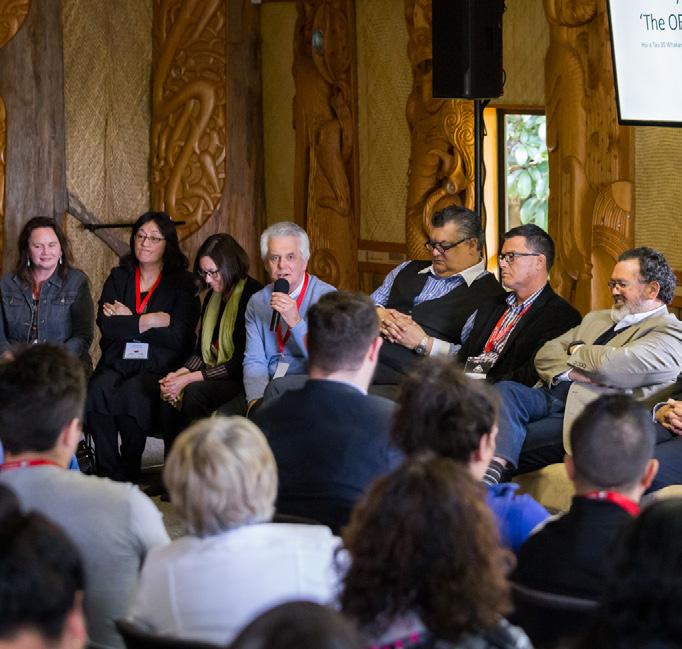
Kaihautū – Te Whare Whakatu Mātauranga at Te Wānanga o Raukawa
There is nothing more potent than a good idea; and Moana was full of them. He may be gone from our midst, but his legacy will endure for generations. Such is the gift of someone who was always ten steps ahead of the rest of us; someone who never failed to take the long view; someone who knew that it wasn’t about him and that it didn’t matter that he would most likely not be here when the changes he talked about came to fruition. It was enough for him that his mokopuna would be here to see it. Creating a better world for his mokopuna was always his chief motivation. Perhaps the most inspirational
thing about Moana was his belief that each of us has the potential to be our best selves; and that if we commit to being our best selves, we can achieve anything. He was legendarily patient. That’s one of many reasons why he was so good at what he did. It’s also why he was so universally loved.
One of his best-known statements is that bravery is just the deep breath you take before doing something difficult. Bravery was one of the qualities that Moana admired most. He embodied it and he encouraged it in all of us, believing that with it we could change the world. I only hope we justify his faith in us. ▪
Issue 954 ∙ W INT e R 2023
15
Aphiphany Forward-Taua (Waikato, Ngāti Maniapoto, Ngāti Hinerangi, Ngāti Raukawa)
Executive Director – JustSpeak
Haere e whai i ngā waewae o Rehua. – Follow in the footsteps of Rehua
This whakataukī denotes if one follows a great chief, such as Rehua, one can be certain of sustenance.
Matua Moana was a legal and jurisprudential mastermind, he was a tohunga of the law, with the ability to carve out complex legal issues and produce convincing and clear solutions to issues of great complexity. He was a humble, kind and honourable descendant of Kahungunu; a Tane Māori who committed his life to honouring his tīpuna, his people, and his whānau. His commitment to a vision of transformational justice for Aotearoa, and especially Māori through upholding Te Tiriti o Waitangi was unwavering. It is this vision of transformational justice that underpins the advocacy work of many in Aotearoa today. The contributions he made to Aotearoa were, and still are revolutionary.
The teachings Matua Moana bestowed on us through stories were profoundly thought provoking. I personally, will never forget the story he told of his tīpuna Hineaka. Hineaka was a wāhine and rangatira of their hapū. Because of her sex, she was denied the opportunity to sign Te Tiriti o Waitangi on behalf of her people. In response to this takahi mana (breaking of mana), her ope (whānau group) simply left. As a budding wāhine Māori rōia, this story demonstrates a number of things, it tells of what mana
wāhine is, the power of tikanga Māori, and how it informs swift yet meaningful decision making. Most of all though, it showed the power of aroha, demonstrated through the immediate support Hineaka received from her people as a rangatira, as a wāhine, and as whanaunga.
The Matike Mai report Matua Moana led envelopes solutions to the constitutional debate around Te Tiriti justice. Addressing this debate, will certainly go some ways to healing the overrepresentation of Māori in the criminal justice system, as he highlighted some 35 years ago in his report, He Whaipaanga Hou – A New Perspective. This report visioned a transformative response to overcoming the perils of a failing colonial system by outlining the differences in Māori conflict resolution, the embodiment of mana by Māori leaders e.g. kaumatua and kuia, and the power of tikanga based decision making.
As great leaders do, Matua Moana humbly left us gifts through his work. These gifts are answers to many of the problems we as a nation continue to grapple with, but especially Te Tiriti. The question remains though, will we be brave enough to endear ourselves to a transformative vision? Or will we continue to do the same thing by tinkering at the edges and expecting a different result? As the legal profession, we have the ability to change the future of Aotearoa for the better, how we choose to do this rests with us. ▪
LAWTALK ∙ KŌR e RO MŌ T e T u R e
16



Issue 954 ∙ W INT e R 2023 Scan this QR code with your phone to read our case study with Corcoran French. Available in the cloud
“I would tell anyone who is considering moving
systems
that they should seriously consider OneLaw.”
CorcoranFrenchmadetheswitchfromtwomajorcompeting systemsin2022.OneLawmadethecomplexdatamigrationeasy. There’s a reason our House, Contents and Car insurance policies have been voted Consumer People’s Choice for seven years running. Find out why at mas.co.nz Proud to be supporting lawyers. Our insurance is choice. 7 17
Steven Duxfield, General Manager, Corcoran French
The aftermath of Cyclone Gabrielle
On Tuesday 14 February 2023, a National State of Emergency was declared in Aotearoa New Zealand.
Between 12 and 14 February, the devastating power of Cyclone Gabrielle saw parts of the country recording rainfall amounts of 300 to 400mm, wind gusts of 130 to 140km/h, and waves recorded as high as 11m along some coasts.1
The cost of asset damage from both the Auckland floods earlier in the year and Cyclone Gabrielle has been estimated by the Treasury at between $9 billion and $14.5 billion.2
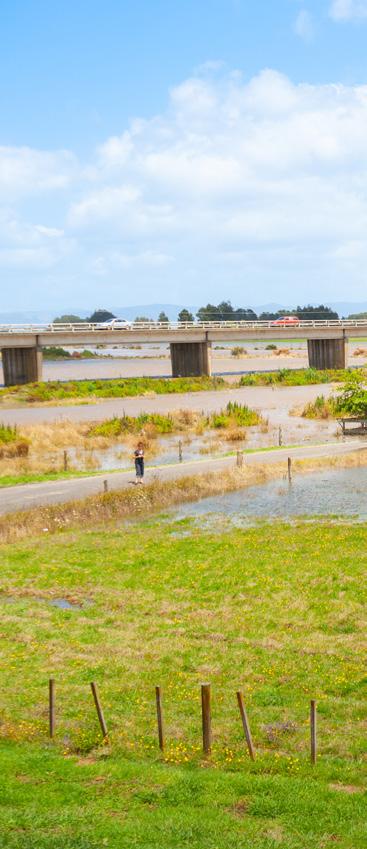
Across the motu, Māori communities were among some of the worst hit and were right on the frontline of the Cyclone response. As Dr Claire Charters, Professor at Auckland University School of Law, wrote, “the response of marae-based communities in many ways defined our national response to Cyclone Gabrielle. Manaakitanga, respect and care for others was placed above all else.”3
Māori communities and iwi organisations wasted no time in providing essential support and resources to those who needed it.
From this catastrophic event, we have witnessed the strength and resilience of Māori shine through.
People-power
Stormie Waapu is a Senior Solicitor at Oranga Tamariki, Hastings, providing legal advice to social workers and managers. Originally from Napier and having worked as a barrister in family law and the youth court in Auckland since 2003, Stormie made the decision to move home in January to put the knowledge and skills she had gained over the years into practice for her own people.
“I had only been working here for three weeks when we were hit by the flood. Though I work in Hastings, I live in Napier. At that time I was living with whānau as we were still looking for a home for myself, my three kids and my partner.”
Aware of the warnings about Cyclone Gabrielle and of previous flooding in her mum’s area, Stormie packed bags for her family and located the evacuation centre in preparation. At around 7am the following day, they lost all power and communication.
“The first time I was able to communicate was when I went to our local Pak’nSave and they had their Wi-Fi on for people. And that’s when we were able to see the devastation that had occurred.”
Stormie’s family living in their papakāinga in Ōmāhu were at the forefront of her mind. The newly renovated house that has been in her family since the 1960s had been completely flooded.
“My aunty, uncle and cousin live in the big house, and there’s a bach in the back that my other aunty lives in… They had just moved in last year around January, and we had all been renovating that house… it looked the best it’s looked and felt the best it’s felt for me, in over a decade.
“It was probably waist-deep the water that went through… So I was just gutted, the silt wasn’t as bad as
LAWTALK ∙ KŌR e RO MŌ T e T u R e
18
some houses but there was mud all through it.”
The majority of Stormie and her partner’s furniture and belongings that they had been storing there whilst looking for a new house were unsalvageable.
“The day I got in, we were told the local hapū had arranged for all our stuff to be collected. So it was a bit of a mad dash to just chuck everything. Unlike some places down here where they were waiting weeks, within a week all our stuff was gone. We had help from our local marae and hapū, people just throwing it into trucks.
“It was really, really tough to see our whole life laid out on the road. And because it happened so fast, any box that was completely wet just got chucked. And it’s only now that I wish I had gone through
those boxes… I lost all of this whakapapa.”
Stormie reflects on the “people-power” demonstrated and the humbling way her local community and Ōmāhu marae have supported each other.
“It has brought our local community closer because the marae was open pretty much every day. People were encouraged to go eat, shower or just sit, and just be together.
“And there were just so many donations… There were people from the Sikh community who came and dropped off food, and other people were dropping off water.”
Stormie commended the Treaty settlement entity for Napier, Mana Ahuriri, for their proactiveness in providing food, water and gas bottles for members of that iwi and the wider community.

“Even where my family come from, everyone is still quite positive and upbeat. It just comes down to our resilience. Even here [at work], we’ve just all banded together, we give each other support. I know a lot of the social workers who work with families have given their time and made sure that those families are getting the help they need.”
Preparing for what is still to come
Marree Kereru is the Kaupapa Māori Lawyer at Tairāwhiti Community Law Centre, covering the geographical area of Tuai all the way to Potaka along the East Coast. Marree is also the current interim Co-Kaitakawaenga and Co-Chair of the Māori Caucus for Community Law Centres o Aotearoa.
The initial impacts of the Cyclone –being without power, internet or phone coverage, and road closures –meant the Community Law offices in Gisborne and Wairoa were closed for around two weeks and they were unable to provide legal advice remotely.
Once back up and running, Marree says, “Our Kaupapa Māori team mobilised quickly, ensuring we were across all areas of advice and support being offered to communities, so we were in a very good position to respond when we started getting Cyclone-related enquiries. We have since provided legal education to Kaumātua on Cyclone-related issues and will continue to be there to support the most vulnerable in our community.”
Issue 954 ∙ W INT e R 2023
19
In those initial weeks of reopening, the centre produced communications following queries they had received around landlords continuing to charge rent and demanding payments from tenants. They also worked with people who had been displaced and were now entitled to accommodation assistance from Work and Income.
In her day-to-day work, Marree and the team run legal clinics, provide legal advocacy and legal wānanga (legal education), covering important topics across the legal spectrum, from family law through to wills, enduring powers of attorney, ACC, trusts, care of children, employment, and property. All of their services are free to members of their community who meet their criteria of not being able to afford legal advice elsewhere. The ongoing State Highway 35 road closures have prevented their Coast clinics from going ahead.
Requests from whānau and
community groups to re-engage via outreach clinics has steadily grown as communications and roads are re-established.
There has been a sharp increase in employment related matters along with increased demand for wills and enduring powers of attorney over the last few weeks.
Marree explains that the need for more phone advice has been difficult for both herself and her Māori clients, who prefer kanohi ki te kanohi (face to face) appointments, valuing the ability to shake hands and be in each other’s space to have that kōrero. Many clients have chosen to wait until they can travel to meet in person.
“My focus has shifted to freeing myself up in order to deal with the influx of Cyclone-related legal issues that we expect to start coming in”.
“We are well aware that many in our community are still displaced,
moving silt, cleaning up and just haven’t had the time or energy yet to seek legal advice on matters.”
Adding to injustice
Whilst the effects of the Cyclone have been felt by communities throughout Aotearoa New Zealand, the pre-existing issues of inequity, access to justice and other disparities for Māori have been further compounded.

Marree says it was already difficult for East Coast whānau to get to Gisborne to attend hearings because of the road conditions, and they now can’t get here at all. Ongoing issues with phone lines being down and patchy reception mean the communication avenues they relied upon to contact lawyers just aren’t there. She also noted that before the cyclone, many in her community couldn’t afford legal services that weren’t supported by legal aid. Now, many in the community are under even more financial pressure and those issues have compounded, making services like those of Community Law even more important to closing the ever growing gap of access to justice for the most vulnerable in our comunities.
Marree also notes that for Māori, justice looks different to what the Crown deems justice to look like. “From a Māori perspective justice is about the future, being able to access good mediation services where everyone’s mana is enhanced, where relationships are important and there’s a restorative process for all parties involved”.
LAWTALK ∙ KŌR e RO MŌ T e T u R e
20
She acknowledges the work Kiritapu Allan (Ngāti Ranginui/Ngāti Tūwharetoa) has done wearing her three ‘hats’ – member of parliament for East Coast, Minister of Justice and the regional lead minister for the cyclone recovery. “She’s been awesome,” Marree said of Minister Allan, adding her role as Minister of Justice and regional lead minister means she has a unique insight into the challenges people in Tairāwhiti are facing in the legal space.
Speaking on the flow-on effect for her own community, Stormie Waapu says, “a lot of our whānau… were already living in poverty, and now they have this additional stress, insured or uninsured.
“The local school was also decimated; they’re going to have to start again and rebuild. So that’s tamariki that are displaced and will have to go to other schools. The local kōhanga is the same.”
Resourcing the first responders
When reflecting on the response to Cyclone Gabrielle, it is clear who should be acknowledged for jumping in to provide immediate and urgent support.
“Māori have shown time and time again their strength and resilience following these events… Marae whānau went back to gathering kai to feed the multitudes, many reached into their own pantries to feed them and New Zealand saw first-hand the manaakitanga that Māori practise so well.
“Community Law recently filed submissions to the Severe Weather Emergency Recovery Bill in support of Marae/Māori organisations being recognised as first responders, for the purposes of being better resourced to respond immediately, following these national disasters,” Marree Kereru says.
Moving forward, we know further impacts of climate change and natural events are inevitable. Ensuring those resources are there and that we have the knowledge to prepare will be vital.
“Tangata Whenua are disproportionally impacted by these natural events and climate change. The Crown has an obligation to ensure it honours Te Tiriti o Waitangi by giving Māori the right to determine their own response and recovery,” Marree says.
“Māori and Indigenous people hold a lot of the answers and a lot of knowledge in relation to climate change and the environment. I really do think that governments across the world should be consulting with Indigenous peoples in relation to policies that are being created.”
Stormie Waapu explains that historically, a lot of areas where communities are being or have been created used to be wetlands. Thoughts around moving away to prevent future generations having to go through the same experience her community has, are met with financial reality.
“A lot of our families can’t afford to move homes or go and buy
land up on maunga like where our ancestors used to live. There’s a lot of challenges for us to face moving forward.”
The beauty of coming together
Thinking about future responses and the current recovery period, Marree Kereru reflects on a meeting with Chief Ombudsman Peter Boshier at Community Law’s Wairoa office.
“We were taken back with how caring he was in his efforts to assist during the recovery phase. I do believe that others working in spaces for cyclone recovery could take a page from his book and get out to the communities affected and sit with people and just kōrero about the assistance we need and how they can best help us, instead of assuming what we need.
“It is often during the aftermath of these events that the rest of the country gets to witness the real beauty of Māori communities, the coming together and support for each other, no matter who they are.” ▪
1. https://blog.metservice.com/TropicalCyclo neGabrielleSummary
2. https://www.beehive.govt.nz/release/ government-rules-out-cyclone-levy-nofrills-budget
3. https://www.stuff.co.nz/opinion/131716871/ mori-should-be-front-and-centre-ofclimate-change-and-weather-disasterresponses
Issue 954 ∙ W INT e R 2023
21
Waitangi Tribunal, Treaty settlements and beyond
 NĀ TARA HAURAKI (NGĀPUHI, NGĀTI POROU)
NĀ TARA HAURAKI (NGĀPUHI, NGĀTI POROU)
Reflecting on developments for Māori within the Treaty of Waitangi legal and political landscape over the past 35 years, the words of Tā Mason Durie in his 2005 work, Nga Tai Matatu: Tides of Māori Endurance, come to mind. Likening the uneven nature of Māori progress to the ocean tide, Tā Durie wrote: “it ebbs and flows and is subject to excesses that can have dramatic repercussions”.
The tide, he observed, also symbolises endurance, which itself is founded on the dimensions of time and resilience. The temporal dimension – time – has a past and a future, but not necessarily a single starting point nor a final destination. Resilience, the second dimension of endurance, also has a past and a future. But unlike time, which “acts as a testimony to progress, resilience is an expression of the effort needed to steer a steady course.” It recognises both adversity and triumph, and celebrates strength of purpose, determination, and capacity to survive – if not in identical shape, then at least in recognisable form.
The Waitangi Tribunal has been fundamental in shaping and telling this story. Its jurisdiction in relation to Treaty of Waitangi claims is unique in New Zealand’s
legal and constitutional framework. The Tribunal inquires into the Treaty-consistency of actions and policies of the Crown and Acts of the legislature, as well as failures to act, develop policy or enact legislation from 1840. The benchmark against which it evaluates Crown action is the “principles” of the Treaty – an acknowledgement that the texts in Māori and English “differ”, and that the Treaty must speak relevantly in today’s world.
Since its jurisdiction was extended in 1985 to claims back to 1840 well over 3000 claims have been filed in the Tribunal. The Tribunal has therefore devoted a large portion of its time and resources over the last 30 years inquiring into and reporting on historical Treaty claims. It has now completed historical inquiries into claims covering 83% of the country by land area.
Historical inquiries are complex. They relate to whole districts and cover a century and a half of interaction between Māori and the Crown. The Tribunal’s reports also do much more than simply catalogue Crown breaches of the Treaty. They provide a comprehensive historical record for claimant groups. For many iwi and hapū, the compilation of a written historical record is just as, if
not more, valuable than the Tribunal’s findings of Treaty breach.
The commitment and effort that has been required by claimants to take their historical claims through the Tribunal process cannot be overstated. Immense amounts of research and evidence is needed to support a claim of Treaty breach. Hearing the claims themselves is a process that can and often has taken many years. Sadly, in many cases by the time the Tribunal has reached the point of reporting on the claims before it, the original claimants have passed away.
Alongside, and sometimes in conflict with, the Tribunal’s historical district inquiry process, the Crown has been engaged in a process of negotiating Treaty settlements to provide redress for historical breaches of the Treaty.
The settlement process had its genesis in the 1980s, when the Waitangi Tribunal’s jurisdiction was extended. Following associated landmark legislative and judicial developments in the late 1980s
LAWTALK ∙ KŌR e RO MŌ T e T u R e
RIGHT: Waitangi Treaty Grounds, Bay of Islands
22
FAR RIGHT: Tara Hauraki, Kaiwawao Matua/ senior Associate at Kāhui Legal
(arising from the Lands and Forests cases in 1987 and 1989 respectively), a Crown policy was formulated for comprehensive settlements between Māori and the Crown of historical Treaty grievances.

The first major settlement following the policy developments of the 1980s was the pan-Māori fisheries settlement, given effect through the Treaty of Waitangi (Fisheries Claims) Settlement Act 1992. The first major Treaty settlements of historical Treaty grievances with iwi groups were completed with WaikatoTainui in 1995 and Ngāi Tahu in 1998 through the Waikato Raupatu Claims Settlement Act 1995 and the Ngāi Tahu Claims Settlement Act 1998.

Since then, approximately 70 Acts of Parliament providing for settlement of historical Treaty grievances have been passed – largely on the model of those first settlements, in
particular the Ngāi Tahu settlement of 1998 which was the first comprehensive settlement of iwi claims.
On the face of it, one might be tempted to say (and many have) that the Treaty narrative over the past 35 years is a story from grievance to settlement and relative collective prosperity. Consistent with this narrative, much is often made about the growing Māori economy. And yes, Māori economic success is surely something to be celebrated. However, as one practitioner put it, the trajectory from “grievance to settlement to governance to commercial success, though true of some iwi, has not been the path for all Māori entities”. Indeed, it should also be recognised that many major contributors to growth in the Māori economy are Māori land trusts and incorporations who have not settled with the Crown. They have been
successful in managing their way through the numerous complexities that they have often inherited in relation to their land with limited or no Crown intervention.
Further, while the achievement of a Treaty settlement is undoubtedly a significant milestone for iwi, it is also inevitably a compromise. The fact remains that Treaty settlements do not address squarely what Māori lost through Treaty breaches, nor what it might take to make material changes to their position in New Zealand society today. While they might act as a “leg-up”, we should be careful about seeing settlements as the panacea to Māori economic disadvantage and disenfranchisement. They are not; a fact borne out by the poor statistics we are confronted with repeatedly in relation to Māori social, economic and health outcomes.
23
Ultimately, the policy considerations for the Crown in Treaty settlement go more to relative fairness – that is, as between settling groups and settlements – than they do to the fairness of the settlements in absolute terms. But even then, there are inequities. For instance, the relativity mechanisms included in the Waikato-Tainui and Ngāi Tahu settlements have never been repeated in subsequent iwi settlements. Similarly, the special relationship Tuhoe, Taranaki iwi or Waikato-Tainui have to their natural resources is not dissimilar to that which other iwi have. But the redress negotiated in relation to Te Urewera, the Waikato River and and Taranaki maunga is not available to all. Treaty settlements are uneven and unequal. Where innovations in settlements are attained, they are hard fought for by the settling groups.
Negotiating Treaty settlements has proven to be incredibly divisive, both internal to settling iwi groups and with other groups who might have overlapping interests. The Crown’s sometimes rigid and/or inconsistent application of its policy has resulted in numerous contemporary claims to the Tribunal and to the Courts.

In this context, it is no wonder that some groups have chosen to forgo Treaty settlement negotiations altogether and have instead attempted to utilise other, and potentially more fruitful, pathways to redress. In recent years, groups in Turanga, Wairarapa and Muriwhenua have sought to have land taken from them in breach of the Treaty returned directly pursuant to the Tribunal’s resumptive jurisdiction. The Tribunal’s powers to make binding recommendations were integral to the Fourth Labour Government’s state sector reforms following the Lands and Forests cases. Yet, notwithstanding that the quid pro quo for the Crown being able to transfer a large area of land to State Owned Enterprises was the additional power given to the Tribunal to make binding recommendations under the new statutory provisions added to the Treaty of Waitangi Act, the Crown has steadfastly and vigorously opposed the exercise of the Tribunal’s resumptive powers. The Crown’s recognition of its Treaty promises then, still comes in ebbs and flows.
Many have viewed, and continue to view, the Treaty of Waitangi as a historical grievance-type issue. For Māori, the Crown’s historic failure
to uphold its commitments has only ever been one aspect of that discussion. Māori have always seen a more relationship-based future for the Treaty.
The Crown has ongoing Treaty obligations beyond settlements. We should therefore resist the notion that the job is done when settlements are reached, or that settlements enshrine the sum of the Crown’s obligations to iwi going forward. To this extent, the Tribunal will, I think, remain integral in shaping the story. Indeed, the many contemporary and kaupapa claims which the Tribunal is only now turning its attention to suggest that it still has a role in helping to steer the course. These inquiries will also, of course, require the Crown to consider different forms of relief to traditional Treaty settlements.
The task ahead may, therefore, be just as challenging as the task that came before. However, the way in which iwi and hapū have navigated the “Treaty” space over the past 35 years is a testament to their endurance – reflecting an ongoing struggle for proper recognition but also a great capacity for adaption and a propensity for turning adversity into accomplishment. ▪
LAWTALK ∙ KŌR e RO MŌ T e T u R e
“While the achievement of a Treaty settlement is undoubtedly a significant milestone for iwi, it is also inevitably a compromise. The fact remains that Treaty settlements do not address squarely what Māori lost through Treaty breaches”
24


Te Reo Māori and Tikanga in our Courts
Pokere v Bodger – Ōuri 1A3 (2022) – tikanga and trusteeship, our first bilingual judgment
NĀ REBEKAH BRIGHT (RONGOWHAKAATA, NGĀTI KAHUNGUNU)
First bilingual judgment
A significant milestone was reached in December of last year when the Māori Land Court issued the first fully bilingual judgment in the history of a New Zealand court, Pokere v Bodger – Ōuri 1A3 (2022) 459 Aotea MB 210. This judgment highlights the growing presence and acceptance of te reo Māori as a language of justice.
The release of this judgment coincided with some other significant anniversaries for te reo Māori and the law; the 50th anniversary of the Māori language petition, the 40th anniversary of te kohanga reo and the 35th anniversary of te reo Māori becoming an official language of Aotearoa New Zealand.
The appointment of Dr Ruakere Hond as a pūkenga to assist the Court, under s 32A of Te Ture Whenua Māori Act 1993, allowed for an expert in both te reo and the tikanga of the relevant area to lend his expertise to the matter. This is the first appointment under this
provision, which allows tikanga experts from the area where the dispute arises to be appointed by the judge as pūkenga.
A feature of the written judgment is that te reo Māori and English are presented side by side in columns, as opposed to a full width version in one language followed by the other.
Judge Aidan Warren, former Tumuaki of Te Hunga Rōia Māori o Aotearoa, received a request from the applicants to be heard and submit in te reo Māori, including in written submissions. Counsel for the applicants, Ms Alana Thomas (as she then was, now Judge Thomas), also a member of Te Hunga Rōia Māori, represented her clients in te reo Māori. In response, the Court appointed Dr Hond as pūkenga and to support the presentation of the applicant’s case in te reo Māori. Te reo Māori is frequently used in verbal submissions and discussion in the Māori Land Court, which is encouraged and supported. The element of receiving written submissions fully in te reo presented an opportunity for the Court to issue the resulting judgment bilingually.
Te Take The Case: Pokere v Bodgers
A trio of applications were brought challenging a decision of the trustees of the Hanataua Trust to evict a long-time occupant of a house on the trust’s land and to demolish that house. The first application was for a review of trust and enforcement of trust obligations, including obligations arising under tikanga. The second was an application to set aside the house site as a reservation and the third sought an injunction to prevent demolition of the whare.
The trustees had taken steps to evict the long-time resident of the homestead and begin its demolition. The applications sought to prevent this due to the importance to the iwi of the whare and the kaitiaki role of its resident. The Kaunihera Kaumātua had also placed a rāhui on the whare to prevent its destruction.
The Court reviewed the tikanga pleaded that apply to the situation and held that the trustees had made their decisions in a proper way,
LAWTALK ∙ KŌR e RO MŌ T e T u R e
Te whakataunga tuatahi i ngā reo e rua
26
RIGHT: Rebekah Bright, Research Counsel, Māori Land Court
finding that they had not breached tikanga nor their statutory trustee duties.
The role of the whare within its context and the role of Ms Warren and her whānau were examined and the Court upheld the trust’s decision to demolish the whare. The Court suggested a course of action to achieve ea (resolution or settlement) in this situation, by holding wānanga to discuss with whānau, beneficial owners and those connected to the land about their aspirations for their whenua and what might replace the current whare.
Ultimately, all three applications were dismissed with the issue of costs to be determined.


Tikanga i roto i ngā herenga kaitaratī
Tikanga and trustee duties
This case highlights the interface between trustee duties and tikanga in the context of Māori land trusts. The trustees, while accepting they have duties under tikanga, argued that it was whānau tikanga, rather than tikanga of the hapū or iwi, that
applied and disputed the applicants’ claim that the whare was like a marae.
Judge Warren and Dr Hond considered the matter of trustee duties under tikanga as well as statutory and common law duties, noting that “there is little doubt that tikanga colours how [Māori land] trustees are to exercise their powers and responsibilities.”
The tikanga aspects put to the Court by the applicants, that the trustees were allegedly in breach of, were kaitiakitanga, whanaungatanga, rāhui and whakamoe whare. The Court observed that these were of two types; the first two being tikanga values and the last two being customary practices. In assessing these arguments, the Court accepted that “whanaungatanga and kaitiakitanga are principles central to guiding persons in leadership roles, including trustees.”
Like the Supreme Court in the Wairarapa Moana ki Pouākani Incorporation v Mercury NZ [2022] NZSC 142 decision, the Māori Land Court emphasised that context was a key consideration in considering tikanga application to legal matters:

We do not seek to prescribe tikanga duties. We will certainly assess the ones pleaded here, but invariably it is the context that will determine what principles or values apply and the specific duties that arise as a result. Similar to fiduciary law, where the duties and remedies arise based on the nature of trustee/beneficiary relationship, as opposed to prescription, tikanga is also relational and context specific.
Whether trustees have duties under tikanga was analysed with the Court concluding that this is specific to each Māori land trust, based on beneficiary expectations in the whakapapa context of the trust.
The Court analysed each of the breaches of tikanga in turn and held that in this case the trustees were not in breach of tikanga; rather, the trustees were exercising their duty to protect the trust’s property, as the house needed urgent repair or replacement.
As noted recently by Acting Chief Judge Fox in speaking on tikanga within the Māori Land Court, this decision is a significant development within the Courts in both its form and approach. ▪
Issue 954 ∙ W INT e R 2023
27
Kia Hohou te Rongo
Restoring Balance through Dispute Resolution
NĀ WI PERE MITA (NGĀTI POROU, RONGOWHAKAATA, TE AITANGA A MAHAKI, WAIKATO – MANIAPOTO)
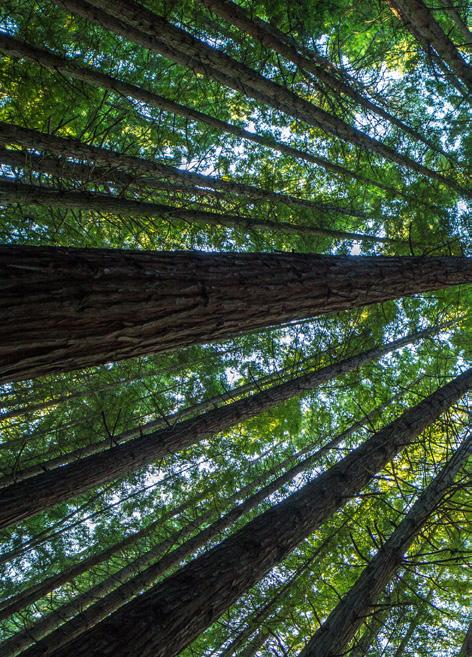
Hohou te rongo is an umbrella term commonly used to describe methods of resolving disputes using principles and values from Te Ao Māori. This goes well beyond the western concepts of mediation, arbitration and the like. The term ‘hohou te rongo’ derives from the Māori god of peace and cultivated food, Rongo-mā-tāne. Therefore hohou te rongo processes can be deeply spiritual with a strong emphasis on the use of tikanga Māori as a means of guiding people towards resolution. Tikanga are cultural norms informed by what is considered correct or tika, given the circumstances at hand. Tikanga practices have developed and evolved over time. For this reason, the practical application of tikanga is often described as being diverse and fluid.
The use of tikanga to resolve disputes is an ancient practice entrenched within Te Ao Māori. Māori creation and navigation traditions as well as tribal histories evidence the use of tikanga in the context of traditional dispute resolution. Those same tikanga principles remain central to hohou te rongo practices today.
Hohou te rongo practices are not bound by one single way of working. In light of the evolving nature of tikanga, models and methods of dispute resolution must be adaptable and flexible to ensure that tikanga are not simply ‘add-ons’ to western processes.
Given the spiritual and therefore sacred nature of certain elements of tikanga-based dispute resolution processes, it is important that such processes are lead or supported by tikanga experts. Equally important is the need for practitioners to be proficient in Te Reo Māori. This is because tikanga is a complex and nuanced set of customs, traditions and protocols. Without a deep understanding of tikanga, practitioners may inadvertently cause offense, misunderstand the perspectives of the parties involved, or fail to create a safe and respectful space for mediation to occur. Transgressions against or breaches of tikanga can bring about severe physical and spiritual consequences that could carry through successive generations. For these reasons, practitioners should be cautious when applying tikanga in the context of dispute resolution.
In recent years, the important role tikanga can play in resolving disputes has been recognised in many formal dispute resolution spaces. For example, the Farm Debt Mediation Scheme (under the Farm Debt Mediation Act 2019), which aims to help farmers, other primary producers and creditors to work through debt issues, allows for tikanga approaches to mediations conducted under the Scheme.
Another example is the ‘Aotearoa best practice dispute resolution framework’ which was developed by the Government Centre for Dispute Resolution. The framework consists of four elements which includes a set of best practice dispute resolution standards. Standard 1 identifies the need for dispute resolution schemes to be consistent with Te Tiriti o Waitangi. This includes ensuring schemes design and deliver Māori culturally responsive dispute resolution services which recognise Te Ao Māori and the use of tikanga and Te Reo Māori.
In 2019, the Tūhono Collective developed a tikanga-based model of dispute resolution derived from Mātauranga Māori unique to hohou te rongo practices. In partnership with Resolution Institute the Tūhono
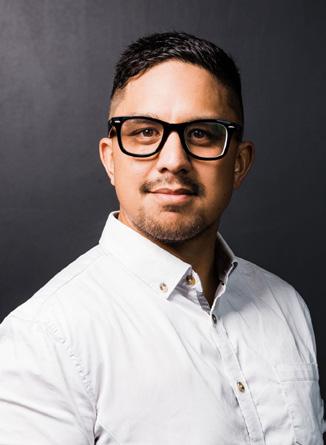
LAWTALK ∙ KŌR e RO MŌ T e T u R e
28
Collective also provide training and formal mediator accreditation in tikanga-based methods of dispute resolution. The main driver behind establishing the Collective and developing the model of practice was to ensure that practitioners seeking to use tikanga when resolving disputes can do so safely and competently. In this respect, there are a number of considerations that practitioners must take into account when facilitating hohou te rongo processes.
Spiritual world – Reciting karakia (in hohou rongo processes is not merely procedural. Decision-making can be wairua based, meaning divine intervention or influence is invoked to guide parties towards resolution. Therefore, the practice of karakia enhances the connection between the natural and spiritual worlds.
Gender-specific roles – Some tikanga can only be observed by a specific gender. A hotly debated example of this is the right afforded (or not) to women to speak on the marae as well as speaking sequences which are dictated by tikanga and kawa. Practitioners must be aware of how these boundaries impact on an individual’s ability to participate in certain processes.
Community structure – Whakapapa is a foundation of a whānau and it places individuals within the whole context of the wider community. This approach also provides, whether intended or not, a hierarchy within society. Therefore, consideration must be given to either perceived or actual power imbalances that might result from whakapapa connections.
Astronomy – Astronomy is also an important aspect of hohou te rongo processes. According to Māori astronomy experts, certain phases of the Māori lunar month present unpleasant days of low productivity. This is the case with the Whiro moon phase, which takes its name from Whiro-te-tipua, the lord of darkness and a symbol of evil within Māori mythology. Certain tribes will not practice hohou te rongo or other tikanga at night. There are varying reasons for this, but there is a common belief that the night brings bad omens or unwanted spirits.
Settlement – Outcomes of hohou te rongo processes do not necessary centre around ‘settlement’. Tatau pounamu, for example, is a tikanga practice around peace making using pounamu as a metaphor to seal
peace agreements, traditionally between warring tribes. In 2015, Ngai Tahu published an article in its iwi newsletter, Te Karaka, which detailed a marae and tikanga-based hohou rongo process over an incident which involved the taking of kereru by a high-profile leader of another tribe. The article speaks of the gifting of a carved sperm whale tooth as a tatau pounamu to symbolise the restoration of peace between the tribes. Local elders described the process as “marae justice being served”.
Ultimately, anyone wanting to practice hohou te rongo must have sufficient and adequate knowledge of tikanga and Te Reo Māori. Remember, if you are unsure simply ask. The following proverb captures these sentiments well:
Mā te kōrero, ka mōhio, mā te mōhio, ka mārama, mā te mārama, ka mātau, mā te mātau, ka ora –through discussion comes awareness, through awareness comes understanding, through understanding comes knowledge, through knowledge comes wellbeing. ▪
Wi Pere Mita is Principal at Laidlaw Law & Consultancy and mediator, trainer and assessor with the Tūhono Collective which represents a community of organisations and individuals dedicated to growing Māori cultural capability, capacity and competency. It delivers bespoke services from a Māori perspective including, coaching, training, mediation services, conflict resolution and facilitation services, cultural support and supervision and more - www.tuhono.nz

Issue 954 ∙ W INT e R 2023
29
LeFT: Wi Pere Mita, Principal at Laidlaw Law & Consultancy, and mediator, trainer and assessor at Tūhono Collective
RIGHT: Kai at Ōtākou Marae as part of the university of Otago second year law wānanga in 2023

FAR RIGHT: Mihiata Pirini, Metiria Turei, and Professor Jacinta Ruru from the university of Otago
Protecting and enhancing tikanga for future generations
Will we recognise the laws of England or the laws of New Zealand and if the latter, will we hone our jurisprudence to one that represents the circumstances of the country and shows that our law comes from two streams?”
Twenty-seven years on, there can be no doubt that tikanga in our law is well-established and a pillar of our legal institutions. But what is tikanga, and what is happening at our law schools in Aotearoa New Zealand to fully incorporate it into the modern profession that is evolving across the motu?
According to Carwyn Jones, “Tikanga is the right or correct way of doing things within Māori society.
“It is a system comprised of practice, principles, process and procedures, and traditional knowledge. Tikanga encompasses Māori law but also includes ritual, custom, and spiritual and socio-political dimensions that go well beyond the legal domain.”
These include systems like
dispute resolution processes, decision-making authorities with corresponding limitations, and unique and culturally appropriate mechanisms for enforcement and redress. Unlike other, western-centric systems, tikanga is not a static cultural artifact that has remained unchanged since 1840. Similar to robust legal systems, tikanga possesses inherent processes that allow it to evolve based on fundamental principles, historical practices, and practical evaluations of the evolving needs of society.
In essence, tikanga Māori encompasses a comprehensive Māori legal system that encompasses all the components of a fully operational and adaptable legal framework.
Tikanga Māori is referred to as “the primary law of Aotearoa” by Māori legal scholar Ani Mikaere, and whether it be through statute, common law or procedure and practice, tikanga has gained recognition and standing within the New Zealand legal system.
Law schools and tikanga
But it is still a concept which is poorly understood by the vast majority of the profession. For a long time, a gaping hole in the knowledge of our profession stemmed from the access and availability of information at law school.
In 2021, the New Zealand Council of Legal Education (NZCLE) decided to amend the regulations prescribing the content of the LLB degree in New Zealand to include teaching and assessment of tikanga Māori. From 1 January 2025, requirements to be progressively introduced include teaching and assessment of the general principles and practices of tikanga Māori relevant to each of the core subjects and Legal Ethics at the LLB level, and tikanga Māori will be taught in its own right as a new compulsory subject for the LLB degree.
Khylee Quince (Ngāpuhi), an associate professor and New Zealand’s first Māori Dean of Law at AUT, described it as a “real game changer.”
LAWTALK ∙ KŌR e RO MŌ T e T u R e
“ 30
“The game changer really is the fact that it’s across-the-board and it’s mandatory.”
But most law schools are already underway with integrating tikanga into their learning programmes. All of our law schools in Aotearoa New Zealand – to some varying degrees –teach tikanga and Māori law and philosophy. Some have been doing it much longer than the 2021 NZCLE decision.

“Some of our law papers have taught about aspects of tikanga Māori for many years, such as our elective paper on Māori land law,” Mihiata Pirini, Metiria Turei, and Professor Jacinta Ruru from the University of Otago said.
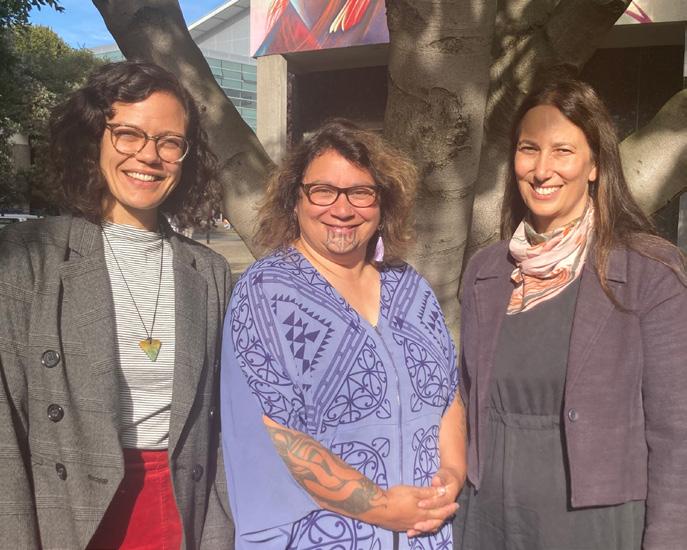
“We are now embarking on a more comprehensive and integrated approach to teach aspects of tikanga Māori into all the compulsory papers in the law degree. In their first year, students learn about tikanga as Aotearoa’s “First Law”, and about the legal and constitutional significance of te Tiriti/the Treaty, from the
earliest Māori-Crown encounters to today.
“In addition, our third year compulsory full year jurisprudence course now has a major focus on Māori laws and philosophy with semester one entirely dedicated to this learning now.”
It’s more than just lecture room learning, however. Pirini, Turei and Ruru explain how they take tikanga out of the classroom and engage on a more holistic, te ao Māori level.
“Our major new initiative this year is an immersive wānanga programme for all 260 of our second-year tauira,
RRachel Geary
which took place over the first seven days of the academic year. The students engaged with mātauranga and tikanga Māori, both in the lecture theatre and on the marae. Students and staff spent a day doing workshops and kapa haka at Ōtākau marae on the Ōtākau peninsula.
“This would have been a major experience for all students but particularly those who have not had much exposure to the practice and procedure of tikanga Māori through, for example, pōwhiri. The wānanga was designed and delivered by Professor Jacinta Ruru, Mihiata Pirini and Metiria Turei

Issue 954 ∙ W INT e R 2023
Remote Transcription & Administration Email: transcription101@xtra.co.nz / Mob: 0276465000
PDF Transcripts of Audio Files, Meetings, Video, Disciplinary Hearings, Skype/Zoom Dictation Typing, Typing & Proof-Reading Document Conversion - Microsoft Word / PDF Accounts/Bookkeeping Experienced & Accurate - Competitive Rates Quick Service / Deadlines - New Zealand Based References Available - Contact me anytime
31
with support from Koro Hata Temo (Office of Māori Development) and two teaching fellows from Te Tumu, our School of Māori, Pacific and Indigenous Studies, Maioha Watson and Maria Tahana.
“From now on it will be a permanent fixture in our second year law programme.”
As mentioned earlier, tikanga is not a static thing. It is constantly evolving and as such the teaching, learning and understanding of tikanga does too.
“We have a challenging and exciting journey ahead of us,” Pirini, Turei and Ruru said.
“Challenging in terms of introducing the teaching of tikanga Māori across all the compulsory law papers and to make sure that it is done so appropriately, in collaboration with the right people and with appropriate support and expertise, both from within the University and from outside it.”
Another view of tikanga in law schools
Almost every one believes the integration of tikanga into the learning programmes at law school is not only important, but a critical part of our development as a legal system and profession. Although Moana Jackson recognised the importance of teaching tikanga Māori as part
of the law degree, he argued that the teaching of tikanga within the Pākehā law degree is highly problematic.
As Hinemoana Markham-Nicklin and Toni Wharehok noted in the Māori Law Revue’s 2021 article “Legal education – reflecting on a bijural, bilingual and bicultural law degree”, “An assumption which sits at the heart of the Pākehā law degree, and the institutions that deliver this degree, is that Pākehā law is ‘the’ law and tikanga Māori is simply an ‘add-on’”.
In reality, they go on to consider, “Pākehā law is the second law of Aotearoa which was forced upon tangata whenua through colonisation.”
“In order to prevent this vicious cycle of epistemological racism continuing within our law schools and law degree, we must listen to Moana’s call to Pākehā staff and students to scrutinise their own culture and realise that Pākehā law is not “the” law but a cultural construct on its own.”
Why it matters
In 2012, the Supreme Court accepted in Takamore v Clarke that “Māori custom according to tikanga is therefore part of the values of the New Zealand common law.” The very
next year, Justice Sir Joe Williams noted that “Lex Aotearoa is very much alive. It is still fragile, but its survival is more certain now than in the past. It is demanding that we change to address its challenges. I hope we Aotearoans are up for it.”
“There is increasing demand from the judiciary for advice on Māori law, especially since Takamore v Clarke,” Professor Jacinta Ruru noted.
“Other parts of the legal profession are recognising this need.
Professional training is being done, for example, to upskill the judiciary on Māori law including time spent on marae. Law firms are engaging in Māori law professional development for their legal staff on Māori law understandings beyond treaty settlement and land law issues due to the needs of their clients.
“We need to ensure all Aotearoa New Zealand law graduates are well prepared for these new expectations in society and within the practice of law.”
Te Aopare Dewes and Nick Wells at Chapman Tripp said that “New Zealand is in a period of transformative recognition of tikanga Māori in the law, now more prevalent in legislation and increasingly being recognised by the courts as an integral part of decision-making.”
“This trend will only continue and eventually public decision makers will need to consider tikanga-based interests. This transformation will, over time, lead us closer to the cultural partnership that Te Tiriti intended.”
Tikanga is not just a ‘nice to have’ in our law schools and institutions – it is setting our next generation of practitioners and legal experts up with the tools and the knowledge to be able to navigate the changing landscape of our legal system. ▪

32
Bringing Te Hunga Rōia Māori together
NĀ RENIKA SICILIANO (WAIKATO, MANIAPOTO)
The Hui-ā-Tau (Annual Conference) has been the highlight of the year for Te Hunga Rōia Māori o Aotearoa for decades. The Conference is designed specifically for Māori lawyers, academics, Judges and tauira. It provides the safe space where Māori within the legal profession can come together to share their experiences, their knowledge and their journeys with one another.
Over the years, Hui-ā-Tau have been held throughout the regions and across the motu. However the larger the number of members for Te Hunga Rōia Māori, the larger the venues have needed to be, taking us to the larger centres like Auckland and Wellington more frequently.
With the advent of formal CPD requirements amongst the profession, the Hui-ā-Tau has provided CPD in spaces relevant to Māori that have not always been available through other avenues.

In 2023, the four-day conference will offer over 10 hours of CPD across five dedicated streams focussing on those take important to Māori, and relevant for those working with Māori in the law.
Hui-ā-Tau 2023
This year, the Conference returns to the Waikato for the first time in a decade.
The University of Waikato and Te Piringa, School of Law, will host manuhiri from across Aotearoa on their Kirikiriroa, Hamilton campus from Thursday 24 August to Sunday 27 August 2023.
The Conference was last planned for Hamilton in 2020 but unfortunately those plans were hampered by the impact of COVID, and the Conference went online. After a very successful conference in Christchurch in 2021 – organised by former Tumuaki Jamie-Lee Tuuta and Carwyn Jones – we returned to an online platform in 2022 due to the continued uncertainty COVID brought. As a result of having only one hui-ā-kanohi in the past three years, we expect to see a large turnout for the Conference.
We acknowledge that the Conference would not be possible without the support of our partners, Kiwibank and Deloitte, together with sponsors including the University of Waikato and LexisNexis.
This number of attendees will only be added to by the fact that this year’s conference will be the biggest offering in Te Hunga Rōia Māori history.
A Full Year’s CPD
It is no mean feat to achieve a Conference programme that caters to all members of Te Hunga Rōia Māori. Te Hunga Rōia Māori members practice across all areas of the law and the Conference must cater to everyone to ensure that our members are able to come together and see an educational benefit.
The theme of this year’s Conference was gifted by Dr Tom Roa (Ngāti Maniapoto, Waikato) from the tongi of Kīngi Pōtatau Te Wherowhero in 1860:
Kia mau ki te whakapono, kia mau ki te aroha, ki te ture.
Hold fast to faith, hold fast to love, hold fast to law.
This embraces all that is important in the current climate and particularly in this, the 35th anniversary of Te Hunga Rōia Māori. It shapes the kōrero to be presented at the Conference. In 2023, the Conference
Issue 954 ∙ W INT e R 2023
33
will include five streams – Whenua/ Te Taiao (Land and Environmental), Te Tiriti (Treaty), Whānau (Family), Taihara (Criminal), and Ture Tauhokohoko (Commercial). Te Hunga Rōia Māori Executive is grateful for the involvement of practitioners across specifical Family and Criminal Kōmiti for taking the lead on the programmes for their respective streams. Keynote and panel sessions also cover some of our most important kōrero including the use of te reo Māori within the law, and keeping safe and well in practice.
The programme includes over 70 presenters including Judges, senior practitioners and academics, without whom Te Hunga Rōia Māori would not be able to function. These kōrero will be just the mauri boost needed to see out the balance of the calendar year following the Conference.

Tauira Involvement
Unique to the annual Te Hunga Rōia Māori conference is the role played by tauira (students).

Tauira are encouraged to attend the Conference to get a taste of what life in the law is like. Importantly, the Conference provides an opportunity to build relationships before becoming part of the profession. A key part of Te Hunga Rōia Māori is ensuring that tuakana-teina relationships are formed from very early on in the law to encourage more Māori within the profession.
Not only that, but for some, the Conference provides a space to demonstrate their technical skills on a greater scale as well. Both the Kaupapa Māori Moot Final and Kaupapa Māori Negotiation Final are held as part of the Conference on the evening of Thursday 24 August. Over the years, these competitions have been a platform to grow and
LAWTALK ∙ KŌR e RO MŌ T e T u R e
34
“Hui-ā-Tau is not just an opportunity to sharpen our legal minds, it is a time for wānanga, for thoughtgeneration and to remind ourselves of who we are and why we are in this profession”
shape young lawyers, and no doubt crystallise future career aspirations.
Not All Seminars and Presentations
One of the most important parts of our programme is the whakawhanaungatanga and whakangahau enabling members to be themselves within the safe space that Te Hunga Rōia Māori provides. The Conference is about more than just legal education, it is a celebration of what makes demonstrating their culture, sharing their journeys and this year, celebrating 35 years of Te Hunga Rōia Māori.
The Conference programme for Friday evening includes Te Matature, a regional kapahaka showcase where practitioners and tauira come together to perform waiata and haka. Te Matature was first added to the Conference programme in 2018 in Te Whanganui-ā-Tara (Wellington)

by former Tumuaki, Rohario Murray and Glenn Tootill. While it may not yet be of Te Matatini quality, the showcase is both competitive and light-hearted with a focus on celebrating and remaining connected to our culture as Māori.
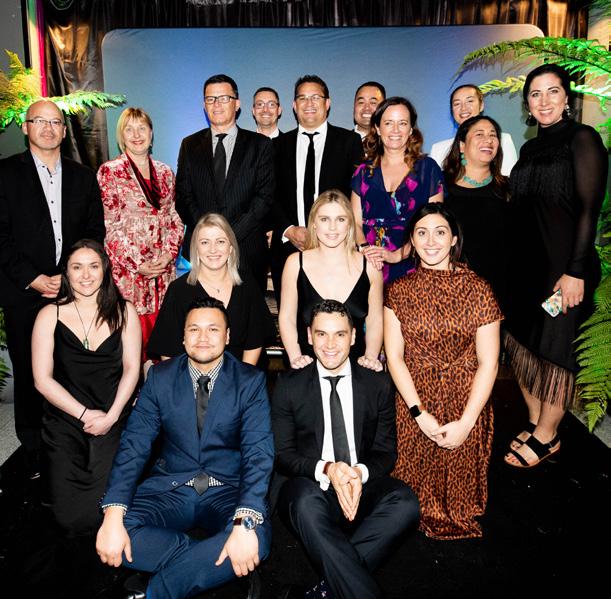
The Saturday programme includes the formal Conference Dinner which will be held at Globox Claudelands Arena with capacity for over 500 attendees. This year, as we celebrate 35 years of Te Hunga Rōia Māori and acknowledge our members in various spaces, the Dinner is sure to be a highlight. For those busy in hearings, with whānau or with other mahi during the week, Conference Dinner tickets are able to be purchased separately.
Hui-ā-Tau is not just an opportunity to sharpen our legal minds, it is a time for wānanga, for thought-generation and to remind ourselves of who we are and why we are in this profession. ▪
LeFT: Attendees at Te Hunga Rōia Māori Hui-ā-Tau 2019 in Wellington
CeNTRe: Past and present McCaw Lewis rōia at the 2019 Conference Dinner
RIGHT: Te Rakau Ture and Auckland practitioners prepare for Te Matature at Pipitea Marae
Save the date for Hui-ā-Tau 2023
24 - 27 August 2023
Kirikiriroa Hamilton
For more information please visit: maorilawsociety. co.nz/en/event/huia-tau-2023
Issue 954 ∙ W INT e R 2023
35
The Independent Panel review
A watershed moment for the legal profession
NĀ BADEN VERTONGEN (NGĀTI RAUKAWA)
In March of 2022 the New Zealand Law Society (Law Society) commissioned an Independent Review Panel (the Panel) to review the framework for the regulation and representation of legal services in Aotearoa New Zealand. The Panel (Professor Ron Paterson, Jane Meares and Professor Jacinta Ruru) released an initial discussion paper in June of 2022, circulated surveys, conducted meetings with members of the legal profession, undertook research, and looked at overseas examples of the regulation and representation of the legal profession.
The Panel’s final report was released on 9 March 2023. That report contains a number of detailed and wide-ranging recommendations about how the legal profession should be regulated.
They cover issues that include whether there should be an independent regulator for the profession – one that is separate from representation functions. They ask about the place of Te Tiriti o Waitangi in the regulation and conduct of the profession. They discuss the approach any regulator should take to protecting the interests of consumers and supporting
practitioners. They consider the scope of what might be regulated, including the business structures allowed within the profession. And they examine issues of diversity and inclusion.
The profession is a diverse one in a number of ways (though, as the Panel points out, not as diverse as it should be in some key areas). As a result, there will be a range of different views about each of the issues that the Panel raises, and there will be much debate to come. But across all of these issues the Panel clearly identifies, and compellingly argues, that change is clearly needed.
The background to why the Panel came about also needs to be kept in mind as part of this discussion, and for why change is needed. This process has its genesis in the 2018 public outcry when the prevalence of sexual violence, harassment, bullying, racism, sexism, homophobia, transphobia and abuses of power in the legal workplace became clear. The forerunner to the Panel is the 2018 Cartwright report that found that this behaviour was ‘part of the fabric of the profession and had been left unchecked for too long’. That report called for changes if the
legal profession was to maintain its reputation and be fit for the future. As a result of that 2018 report some changes were made, such as requiring the mandatory reporting of misconduct, and the definition of this extended to include sexual misconduct and bullying. But deeper changes were needed to ‘the fabric of the profession’. The work of the Panel picks at that fabric, and that context is important to keep in mind.
Part of the reason why considering change can be so challenging for some of us is because the issues driving the need for those changes do not necessarily affect us all in the same way. If you have not had the experience of being sexually harassed or bullied, have never been mistaken for a defendant rather than a lawyer at Court, have not felt the pressure of being one of a small minority in a profession that is not representative of the wider population, then it may be challenging to see the experience that others have had and see the need for change.
But these things, and others, do happen and change is needed.
If this has been your experience, then your views on the matters grappled with in this Report are
LAWTALK ∙ KŌR e RO MŌ T e T u R e
36
needed in continuing to push for change and to help develop a profession where this does not continue to occur. Your voice is important.
If these things have not happened directly to you then listen to, and hear, the voices of those to whom they have. Then consider whether or not you are happy that the profession that you are part of enables this, and whether it is the type of profession that you want your sons and daughters to be part of.

Change can also be confronting and challenging because we are tied to our history. Law Society has – for some – a long and illustrious history that stretches back to its establishment in 1869. But for others, we see 1869 as being a year when Pākehā New Zealand was still at war with Māori in parts of Aotearoa such as Taranaki and Tairāwhiti. NZLS has a history and structure that does not
look to our founding constitutional documents, such as Te Tiriti, for its legitimacy and to help define its relationship with Māori. The Law Society’s history is one of significant achievements – but it is also a history where it took 28 years before women and Māori became part of the profession, 103 years before a Māori woman was a member of the profession, and 148 years before a Māori judge sat on our appellate courts. The systemic problems with ‘the fabric of the profession’ that led to these outcomes are still there –many groups remain underrepresented in key, and senior, parts of the profession. Change is needed and overdue.
The discussion about what the change should look like will be an important opportunity for those members of the profession who haven’t been able to see or hear themselves reflected in the
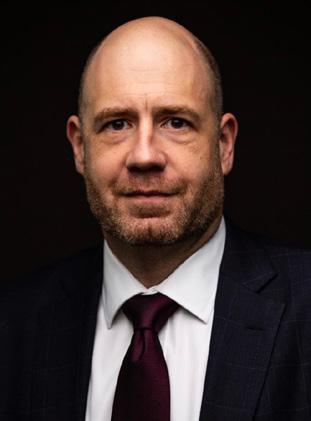
representation and regulation of the profession in the past to have their say. NZLS, and its successor(s), must provide a whare that is inclusive and accountantable to represent and regulate all of the profession. It therefore needs to be a body (or bodies) where all parts of the profession can see themselves reflected and see some legitimacy for its role.
What happens next with the Panel’s report, and their recommendations, now sits with the profession itself and with the Government. This is a ‘once in a generation’ opportunity to build a profession that looks to the future and is not chained to the problems of the past. But seizing that opportunity will need a broad range of members of the profession to have their say, and for others to listen and hear those voices. We now all have a responsibility to speak and to listen. ▪
Issue 954 ∙ W INT e R 2023
37
He Kai Kei Āku Ringa –Financing Māori freehold land
Approximately 1.4 million hectares of land in Aotearoa is Māori freehold land with an average Māori land block being 53.07ha and having 111 owners (Māori Land Update June 2022). With the current housing crisis, cost of living increase and disproportionate rates of Māori homeownerhsip Māori are looking to utilise and develop their whenua for housing and papakāinga.
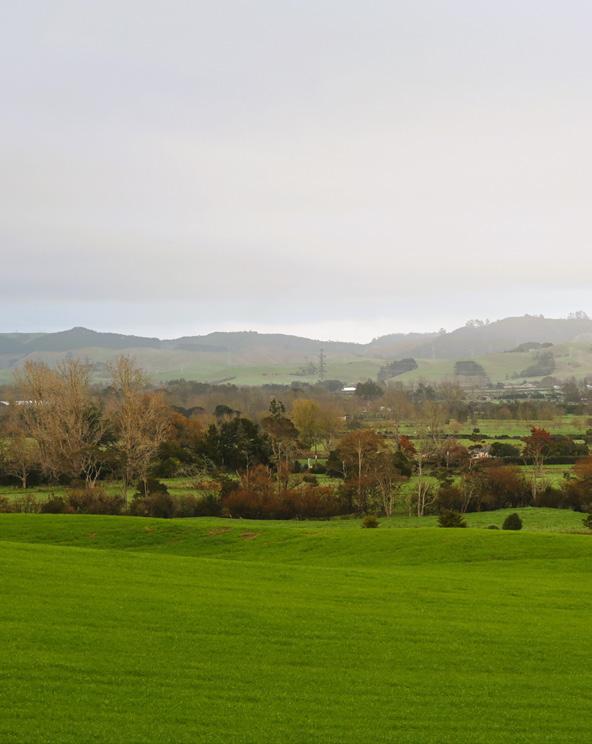
An important aspect of building on Māori land is financing. Historically lending on Māori land has been a long standing barrier for whānau, hapū and iwi looking to return to provide housing on their whenua – I know this from experience.
In 2014 after two years of navigating multiple mortgage brokers, lending institutions and the Māori Land Court I was able to buy back our tupuna whenua, land my tupuna cleared by hand, lived on and raised our whānau on, land where my dad was born on and where my daughter’s pito lays. Through time and urbanisation the whenua fell into non Māori ownership but
retained the status of Māori freehold land. The journey was one that at the time disheartened my father who could not understand why we would have to endure a battle with banks for a minimal loan amount to purchase the whenua because it was Māori freehold land when we could secure more lending against general land without any hurdles. It was eventually through the creating of a whata order through the Māori Land Court that we were able to facilitate the lending and return to our whenua.
The late Moana Jackson spoke on the importance of stories in the whenua, of our history and whakapapa which lies in the whenua and continues to speak to us. The ability to reconnect with the whenua and invigorate the kōrero have been invaluable for my whānau with three generations now living on the whenua.
My first had experience with the barriers of securing financing for Māori freehold land drives me to practice in the area of Māori land law and assist Māori landowners to navigate
barriers for financing Māori freehold land. It is through this mahi that I am often guided by the vision of Te Hunga Roia Māori – ma te ture mō te iwi – by the law for the people. The law in this case is Te Ture Whenua Māori Act 1993.
Historically financing Māori freehold land has been met with reluctance by lending institutions, despite the fact Māori landowners are in a secure financial position to service a mortgage or loan. This appears to be largely due to the status of the land and an unwillingness to accept security over Māori land because of multiple ownership structures. In more recent times schemes such as Kainga Whenua loans provided by Kiwibank have turned the tide on lending on Māori freehold land.
With any lending, regard must be had to Te Ture Whenua Māori Act 1993. While the Māori Land Court does not have a role in granting finance, there are considerations Māori landowners need to have regard to in securing finance and meeting their obligations under the Act.
LAWTALK ∙ KŌR e RO MŌ T e T u R e
NĀ KYLEE KATIPO (WAIKATO)
38
Lending on Māori freehold land is a form of alienation for the purposes of the Act and different considerations apply for sole owners, joint tenants, owners in common, trusts and incorporations. In addition, those seeking financing will also need to provide to their bank valuation of the land and satisfy their bank of the ability to service the mortgage or loan.
For sole owners and joint tenants of Māori land a certificate of confirmation will be required from the Māori Land Court under s 160 of the Act. Until the mortgage instrustment has received a certifcate of confirmation, the instrument will have no force or effect. It is important to note this takes a mandatory one month before the certificate can issue. Owners will need to ensure their lending offer takes into account these time frames.
For owners in common lending presents a different challenge as landowners don’t have the ability to obtain a mortgage over their separate ownership interests. This means all owners together must agree to

the lending. This is likely to present significant issues with lending institutions who will need certainy around servicing the loan. Where lending is obtained, owners will also need to seek a certificate of confirmation from the Māori Land Court.
For trusts and incorporations trustees or committee members should first ensure they have the power to borrow under their trust order or constitution. It will also be important to consider broader duties of prudency and the objectives of your trust or incorporation. Trustees and committee members will also need to ensure their trustees or committee members are up to date, if any resignations or replacements have not been processed through the Māori Land Court this will need to occur so that the correct trustees and committees can enter into the loan arrangements. It is also likely the banks will require AML identity checks for each of the governance members. This can often delay matters where financing is secured first as Māori Land Court applications take time to process. Once the lending is secured, trustees and incorporations will also need to ensure compliance with the Act by ensuring copies of the mortgage documents are to sent to the Māori Land Court for noting.
The challenge is to achieve an all encompassing approach between lawyers, banking institutes and the Māori Land Court to further reduce barriers for Māori landowners to return to their whenua and empower Māori landowners to utilise and develop their whenua in their own hands. ▪
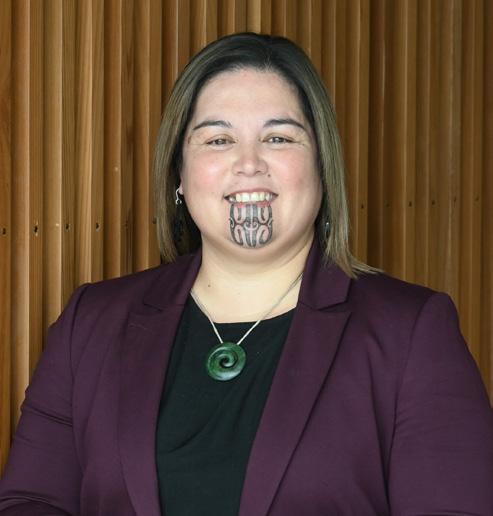
Issue 954 ∙ W INT e R 2023
“The ability to reconnect with the whenua and invigorate the kōrero have been invaluable for my whānau with three generations now living on the whenua”
39
LeFT: Kylee Katipo, Managing Associate at McCaw Lewis
Online CPD – learning on demand

You choose from 3 easy options
• Instant access modules
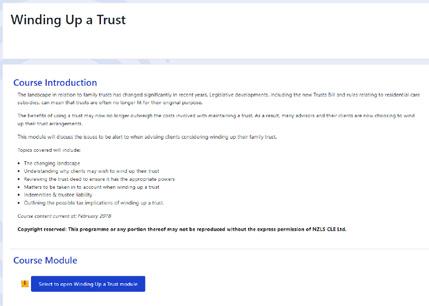
• Pre-selected packages
• Pick ‘N’ mix packages – your choice
Then enjoy 7 great benefits
• CPD compliant
• Presented by subject matter experts
• Extensive range of practice areas
• Convenient 24/7 access – you choose when and where
• Learn at your own pace
• Complete all at once or pick up where you left off
• Bonus electronic booklet & powerpoints
Get your last minute CPD points now!
By visiting www.lawyerseducation.co.nz
www.lawyerseducation.co.nz cle@lawyerseducation.co.nz

New Zealand Law Society Practising Fee
Practising certificate fee to rise by $140 in 2023-2024
In the last two years the Law Society has increased funding to modernise and improve our regulatory functions in line with the Regulatory Strategy (lawsociety.org. nz/about-us/our-regulatory-strategy). This modernisation work is planned to continue this year, including investing in the Law Society’s regulatory operations, new IT systems, improving compliance and focus on consumers. Similar to all businesses, we are also facing cost increases. As a result, the practising certificate fee for 2023-24 will rise by $140, to $1430 (GST exclusive).
Modernising and improving technology

The practising certificate fee increase for 2023-24 will enable the Law Society to continue its technology modernisation programme to support core regulatory processes, and include further development of the Law Society website and improving the provision of information.
Recent fee increases from 2021 onwards allowed for some improvements which have already been implemented, such as the reform of our early resolution and frontline processes and technology modernisation programme. Many of these
improvements are aimed at lessening delay and ensuring the complaints process is more efficient and effective within the current prescriptive legislative framework. We have also improved the stability and security of our core IT systems. We’ve also put more resources into our management of sensitive matters and to provide more support in this area.
This is consistent with the findings of the Independent Review Panel which considered there had been systematic underfunding of the Law Society’s regulatory functions. The Panel said an effective regulator needed to set its budget based on what was needed to effectively and
Issue 954 ∙ W INT e R 2023
$1,110 2010 $1,000 $1,100 $1,200 $1,300 $1,400 $1,500 2011 2012 2013 2014 2015 2016 2017 2018 2019 2020 2021 2022 2023 2024 $1,110 $1,132 $1,183 $1,202 $1,213 $1,231 $1,235 $1,240 $1,267 $1,281 $1,300 $1,332 $1,419 $1,521 $1,340 $1,130 $1,140 $1,160 $1,170 $1,182 $1,192 $1,192 $1,140 $1,140 $1,290 $1,430 $1,040 $1,040 $1,040 YEAR ENDED 30 JUNE PRACTISING FEE ($) Actual Practising Fee
ACTUAL VS CPI ADJUSTED If CPI adjusted annually since 2009 41
efficiently regulate. See Regulating Lawyers in Aotearoa New Zealand (lawsociety.org.nz/assets/IndependentReview/IR-Report-Received/Regulationof-lawyers-final-report-for-submission. pdf ), page 57 Systematic underfunding of regulatory functions.
Lagging behind inflation
Historical reductions and holding of the practising fee meant that it has not kept pace with CPI increase every year. The practising fee was increased by $150 to $1,290 for 2022-23.
The chart on the previous page shows the history of the practising fee and the impact of the $140 increase.
The practising fee was reduced in 2017 and 2018 then held steady for three years. In 2019 the Law Society had to vacate its national office building and then a decision was made not to increase the fee during COVID due to the pressures faced by the profession. This resulted in limited increased funding for the Law Society which contributed to a lack of continuous investment in systems, process, technology and staff resources to improve and maintain regulatory services.
What does your practising certificate fee pay for?
It’s worth noting that the practising certificate fee is not a membership services fee and only pays for the cost of professional regulation. By law, practising certificate funds can only be spent on regulatory work. The Law Society’s representative services are not funded by the practising certificate fee.
Practising fee breakdown
All practising lawyers in New Zealand pay a practising fee and levies to the New Zealand Law Society, which funds the regulatory activities for the Law Society.
Under the Lawyers and Conveyancers Act 2006, funding received from practising certificate fees can only be spent on regulatory activities. The practising fee is $1,430 for the 2023/24 year.
Complaints
Under current legislation, all complaints received by the Lawyers Complaints Service must go to an independent Standards Committee for processing. The Lawyers Complaints Service currently receives around 1200 complaints per year.
Funding for complaints covers a range of activities from overseeing and investigating complaints, to disciplinary matters.
Registry
The Law Society is required to maintain a register of all lawyers who hold practising certificates – currently over 16,000 lawyers. Should a lawyer wish to practise on their own account ie take direct responsibility for advising clients, then they must receive approval to do so. Some applications will be considered by a Practice Approval Committee.
Legal
The Legal team work to support the Professional Standards (Regulatory) department. This work includes prosecutions and litigation.
Law reform
The Law Society makes regular submissions on draft legislation with the aim of being an objective and neutral contributor to better quality law. So far in 2022/23 the Law Reform Committees made submissions on 27 bills and 75 submissions overall including government consultations.
Law libraries
The Law Society provides staffed research library services
LAWTALK ∙ KŌR e RO MŌ T e T u R e
42
“Under the Lawyers and Conveyancers Act 2006, funding received from practising certificate fees can only be spent on regulatory activities. The practising fee is $1,430 for the 2023/24 year”
in Auckland, Wellington and Christchurch as well as 44 kiosks for online access.
Operational costs
Operational costs include governance and administrative functions, IT and Communications support, and other corporate services and projects as well as broader regulatory functions.
Other fees and levies
The profession is also levied to contribute to the costs of operating the New Zealand Council of Legal Education and the Legal Complaints Review Officer. The LCRO’s role is to review decisions of Standards Committees.
Those practising on their own account fund the costs of the Law Society Inspectorate. If they operate a trust account, they must contribute to the Fidelity Fund.
*The graphic and information on this page does not cover any membership services or branch activities that the Law Society conducts as practising certificate fees can only be spent on regulatory activities.
*Figures used to generate the percentages are based on the 23/24 financial year. ▪
Complaints 19% Registry 9%
Legal 13%
Law Reform 4%
Libraries 12%
Operational costs 36%
Strategic projects 7%
Council of Legal Education Levy $19
LCRO Levy $100
Inspectorate Fee $460
Fidelity Fund Contribution $200
Issue 954 ∙ W INT e R 2023
PRACTI s ING F ee $1,430
Paid by barristers and employed lawyers
Paid by barristers and solicitors practising on their own account
Paid by barristers and solicitors practising on their own account with a trust account
43
FOR A WORLD THAT IS ON FIRE, CAN THE OLD PRINCIPLES OF ENVIRONMENTAL PROTECTION BE THE WAY FORWARD?
IS IT TIME TO RETHINK THEM?

Challenge accepted thinking. Become an expert in Environmental Law at NZ’s leading Law School.
law.auckland.ac.nz/pg-study






















 NĀ TARA HAURAKI (NGĀPUHI, NGĀTI POROU)
NĀ TARA HAURAKI (NGĀPUHI, NGĀTI POROU)




























